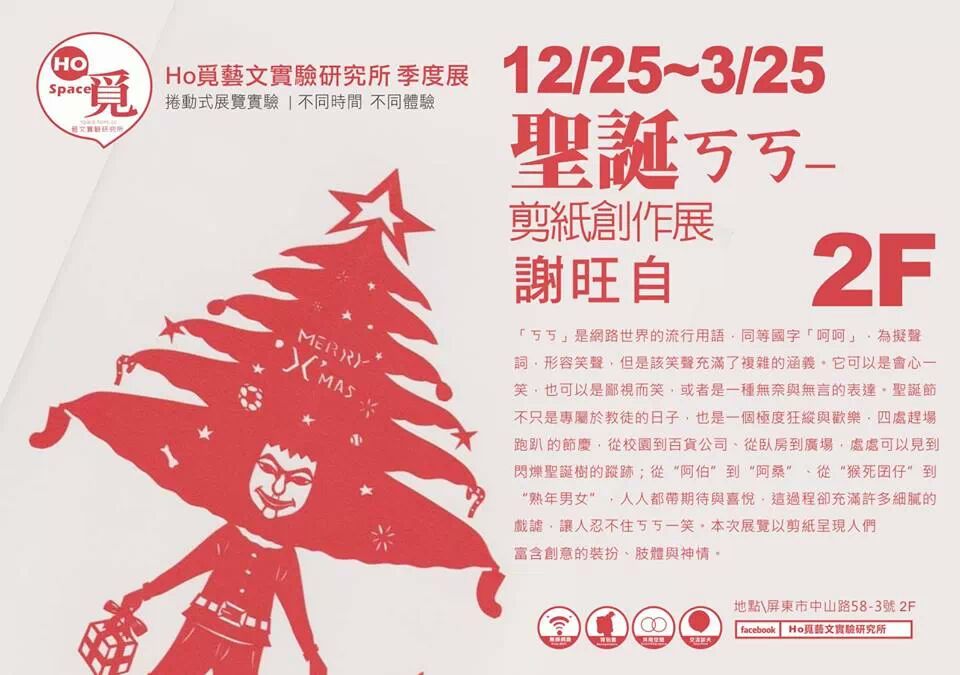Multiscript Taiwan advertisement
« previous post | next post »
Jason Cox sent in the following ad for a Christmas-themed exhibition of papercutting artwork from Taiwan:
Even if one doesn't read Chinese, one can immediately notice that the ad contains three different scripts: Chinese characters, Roman alphabet, and zhùyīn fúhào 注音符號 ("phonetic symbols", also called bopomofo after the first four symbols in the set).
The zhuyin symbols ㄎㄎ that appear prominently after the two large characters Shèngdàn 聖誕 ("Christmas", lit., "sacred birth") are pronounced kēkē and represent the sound of laughter. This usage is actually spelled out in considerable detail in the paragraph of smaller print in the bottom right quadrant of the ad. This use of ㄎㄎ to indicate laughter is widespread on the internet, etc. in Taiwan. According to the Wikipedia article on the PPT Bulletin Board System, ㄎㄎ may be changed to kēkē 科科 when the use of bopomofo is prohibited.
In characters, the sound of laughter is also written as kēkē 呵呵 (never mind that 呵 may also be pronounced as hē or a [i.e., sounding like "ah"]). The onomatopoeic function of kēkē 呵呵, with the repeated mouth radicals, is obvious, whereas the kē 科 of kēkē 科科 literally means "branch; subject; division", etc.
In online communication, the sound of laughter (kēkē) is also often represented simply by the Roman letter "k" repeated, hence "kk".
"Ho Space" seems to be the English name of the sponsoring group. Their website may be found here.
Mì 覓 normally means "seek; look / hunt for", but here it is used to render the sound of a Taiwanese morpheme. Thus Taiwanese "homi" means "good thing", e.g., wǒ zhǎodào yīgè homi 我找到一個homi ("I found something good").
In commenting on this type of usage, one of my Taiwanese graduate students remarked:
Taiwan people are so creative! I frequently wonder if what they do is "post- post- postmodernism" or "de- de- deconstructionism", or something else…
In any event, it is quite common for people in Taiwan to add zhuyin (phonetic symbols) in sentences to convey Taiwanese morphemes. The following are a couple of sample FB entries that mix characters and zhuyin:
孫立言 對呀!看起來場地很優ㄟ!
September 21 at 1:49am
Mien-Chiao Ku 離開溫暖ㄉ國度….
December 13 at 10:06pm
In essence, when it comes to writing, Taiwan has a sort of trigraphia, with Chinese characters, Roman alphabet, and zhùyīn fúhào 注音符號 ("phonetic symbols") all being used in appropriate circumstances. Mainland China also has a kind of trigraphia, with simplified characters, traditional characters, and the Roman alphabet being utilized as circumstances warrant. Both in Taiwan and in the PRC, the situation with regard to writing is very fluid.
[Thanks to Grace Wu, Melvin Lee, and Chia-hui Lu]

David on Formosa said,
December 29, 2013 @ 4:35 am
Taiwanese people colloquially refer to this trigraphia as "Martian language" (火星語).
Vanya said,
December 29, 2013 @ 10:15 am
Is it possible that the long period of Japanese political control and exposure to the Japanese writing system (which mixes characters and phonetic syllabaries) made Taiwanese more open to the idea of mixing characters and phonetic spellings than other Chinese populations might be?
X said,
December 31, 2013 @ 1:49 pm
It's a bit puzzling, isn't it? Bopomofo are by design explicitly phonetic, yet here they're being used in an abbreviation of the full phonetic description of the sound ("k-k-" instead of "keke"). I wonder if it's more likely that the original expression 呵呵 became "kk" explicitly in Roman (where "k" the letter is to be pronounced "kay"), and that was only later bopomofoized in order to appear more Taiwanese while losing any intelligible phonetic interpretation.
John said,
January 1, 2014 @ 9:49 pm
X, I think the sound is actually k-k- which is not representable in characters. For example, I have seen Koreans use ㅋㅋ when if what you said is true, they would type 크크